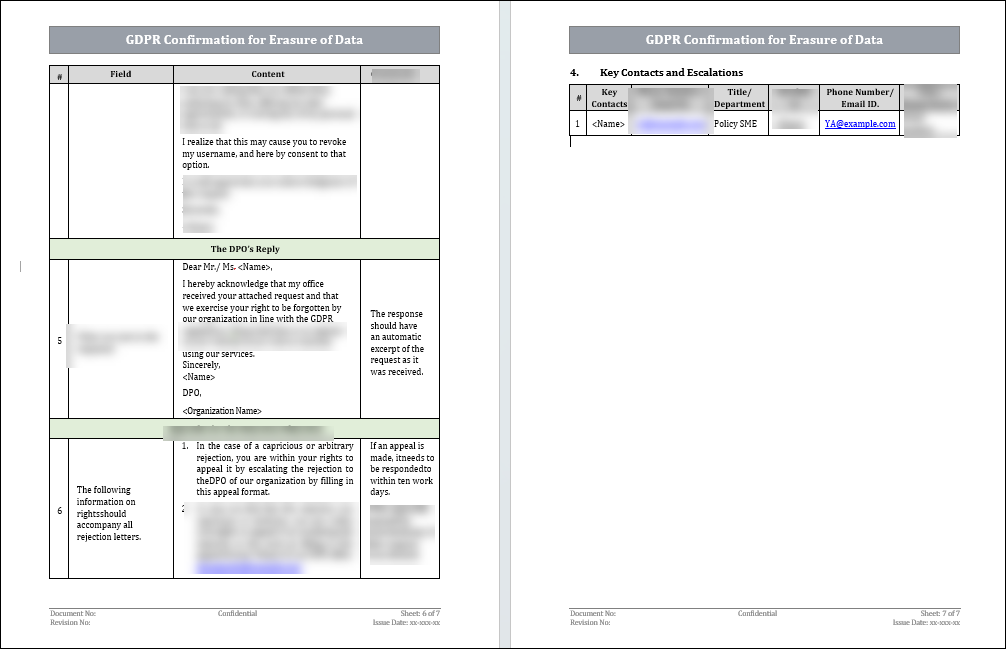GDPR Confirmation for Erasure of Data Template
Introduction
The General Data Protection Regulation (GDPR) Confirmation for Erasure Data Template is a document used by organizations to formally acknowledge and confirm the deletion or erasure of an individual's personal data in compliance with the GDPR. This template serves as a record of the erasure process and helps demonstrate the organization's commitment to respecting individuals' rights to have their personal data removed under the GDPR.

Here Are Some Of The Key Details About The GDPR Confirmation For Erasure Of Data Template
The Process: The purpose of the GDPR of the confirmation document is to inform the requester whether their request will be complied with or not. The process is to fill in the template and send it to the requester.
Compliance Obligations
The request to "be forgotten" must be complied with if the following circumstances are applicable -
- The personal data isn't required anymore for the purpose that it was initially collected for
- The end-user who initially gave consent has now withdrawn it
- The processing (manual or automatic) of the personal data is unlawful
The confirmation letter deems that the request is justified and has been complied with.
Exemptions from the Right to Erasure:
- The data is still being used for its original intended purpose
- The personal data is required for a lawful hearing or process
How to Respond to Requests for Erasure?
Fill in the template and send it to the requester.
What Happens If the organization doesn't comply with the request for Erasure?
That organization will violate a GDPR statute.
GDPR
1. The GDPR applies to all organizations that process the personal data of individuals in the EU.
2. The GDPR requires organizations to comply with several requirements, including:
- Getting people's permission before using their personal info
- Assuring the lawful and equitable processing of personal data
- Guarding against the misuse, access, and disclosure of personal data
- Erasing personal data when it's no longer required
What Information/Actions Are You Obligated To Provide In A Confirmation Letter?
The rectification response should include the following fields:
- The details of the DPO or their delegate
- The basic details of the requester
- The request summary as submitted by the end-user
- The reply of the DPO
- Inform the end-user of their right to appeal the rejection decision to the supervisory authority.
How Can Data Subjects Submit An Erasure Of Data Request?
Data subjects can submit a request for data erasure to an organization through various methods, depending on the organization's processes and the available communication channels. Here are common ways that data subjects can submit these requests:
1. Written Request: Data subjects can send a written request by mail or email to the organization's designated contact address for the request. The request should clearly state that it is an erasure of data and provide the necessary details to identify the data subject.
2. Online Forms: Many organizations provide online forums on their websites that data subjects can use to submit requests. These forms may prompt the data subject to provide the necessary information for verification.
3. Customer Service Channels: Data subjects can contact the organization's customer service department or designated erasure requests contact to initiate the request verbally or through written communication
4. Dedicated Email Address: Some organizations have a dedicated email address for submitting requests. Data subjects can send their requests to this email address, ensuring that the request is directed to the appropriate team.
5. Personal Accounts: In cases where data subjects have personal accounts on websites or platforms, they might be able to initiate an erasure request directly from their accounts, allowing them to access and manage their personal data
Organizations must respond to the erasure requests within the time frame mandated by data protection regulations, typically within one month. They must verify the data subject's identity before disclosing any personal data to ensure the security and privacy of the information.

Who Responds To An Erasure Request?
The erasure request is typically responded to by the organization that collects and processes the individual's personal data. The responsibility for responding to an erasure often falls within the purview of several roles within the organization.
1. Data Protection Officer (DPO): If your organization must have a Data Protection Officer (DPO) under data protection regulations such as GDPR, the DPO may oversee and coordinate the response to the erasure requests. The DPO ensures that the organization's procedures comply with relevant laws.
2. Privacy or Compliance Team: Organizations often have dedicated privacy or compliance teams responsible for data protection. This team may oversee the processing of the erasure requests, including verification, data retrieval, and response.
3. Legal Department: The legal department may be involved in reviewing the erasure requests, ensuring that responses align with legal requirements, and providing guidance on sensitive data or legal issues
Key Takeaways
- The request must be complied with within a timely manner.
- It must be in understandable everyday language.
- A copy must be saved for audit purposes.
- The requester may appeal the decision.
- Monitor the Erasure of the data.



